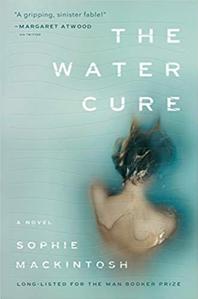
 The Water Cure is a dream-like study of sisterhood, patriarchal norms and what it means to be a woman. Three sisters live in an island compound protected by barbed wire and traps, forced to undergo bizarre acts of self-punishment and denial by their parents in the name of staying healthy. But when their father disappears and three strange men arrive at their door, the small world constructed for the women begins to burst open. Sophie Mackintosh's debut is built like one of the family's traps, turned tight in the opening pages and ready to spring.
The Water Cure is a dream-like study of sisterhood, patriarchal norms and what it means to be a woman. Three sisters live in an island compound protected by barbed wire and traps, forced to undergo bizarre acts of self-punishment and denial by their parents in the name of staying healthy. But when their father disappears and three strange men arrive at their door, the small world constructed for the women begins to burst open. Sophie Mackintosh's debut is built like one of the family's traps, turned tight in the opening pages and ready to spring.
Grace, Lia and Sky have grown up knowing little other than the world their parents built for them: daily rituals intended to keep outside contamination at bay, a sheltered existence and the ever-present fear of men other than their father, King. As a result, the strange appearance of the men, claiming to be shipwrecked, forces each young woman to rethink the rules and culture of the compound. Grace, the eldest, follows her mother's forceful defiance of this new male presence, while Lia is intrigued, and begins to move closer to one of the intruders as she expands the limits of her world and experience. Sky, too young and too bound to her parents' traditions, watches helplessly as her sisters are pulled in opposite directions, made all the worse when their mother suddenly disappears. Taught from childhood that men are a threat, the sisters must now decide how to deal with this incursion.
In different hands, The Water Cure might have been a thriller, a twisting cat-and-mouse game where the sisters and their guests continually gain and lose the upper hand. But Mackintosh is more interested in how Grace and Lia perceive masculinity, how it toxifies their relationship and lives. As narrators, the two sisters fret and consider, each thinking through her past to make choices in the present. The three men, James, Llew and his son, Gwil, are more signifiers than real people, each taking on a different shade of archetypal maleness, and all are unlike King, an apt name for the father who disappears from his compound forever. The Water Cure examines how its protagonists navigate their bodies and identities in relation to King's rules and, when he is gone, the rules of deportment with their new guests.
The Water Cure lives and dies by its two main narrators, and Mackintosh makes Grace and Lia vivid. As sisters raised in a place with few interlocutors, their voices and commitments are similar, but Mackintosh shows the breaks between them in their needs and reactions to the newly arrived men. Some chapters are told in unison, with all three sisters speaking as one, as if they are a part of a greater whole of womanhood.
The Water Cure ultimately ends in a show of how powerful the wills of the three sisters are. Fans of haunting works that probe identity will find a lot to love in its pages, as will anyone who likes stories that deconstruct notions of gender and power. --Noah Cruickshank, adult engagement manager, the Field Museum, Chicago, Ill.
Shelf Talker: The Water Cure is a dream-like book that deftly explores questions of gender, power and identity.

